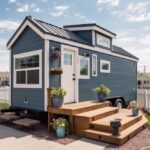
Tiny houses are the talk of the town! With their allure of simplicity, minimalism, and a lesser environmental footprint, they are quickly becoming a favorite living solution for many. But there’s one challenge almost every tiny house enthusiast faces – the question of space. How can you live comfortably, storing all your essentials without feeling cramped? Let’s embark on this space-saving journey together.
Multi-purpose Furniture is Your Best Friend
When space is limited, each piece of furniture needs to justify its presence. Think of sofas that can convert into beds or tables with storage underneath. Ottomans with hidden compartments, fold-out desks, and expandable dining tables can be lifesavers in a tiny house. These multi-purpose pieces not only save space but also give you the flexibility to quickly adapt to different needs.
Think Vertical: Use Wall Space Efficiently
Often, when thinking about space, our minds tend to focus on the floor. But what about the walls? Install shelves near the ceiling or use pegboards to hang kitchen utensils, tools, or even plants. Wall-mounted fold-out desks or drop-down tables can serve as workspaces when needed and disappear when not in use. Remember, every inch counts!
Declutter and Embrace Minimalism
Possessions tend to accumulate over time. Before moving into a tiny house, or even if you’ve been living in one for a while, regularly assess what you truly need. Do you use that waffle maker often enough to justify its presence? Embracing a minimalist lifestyle doesn’t mean living without comforts; it means prioritizing what’s truly essential and letting go of excess.
Smart Storage Solutions
Having limited space doesn’t mean you can’t store your essentials efficiently. Under-bed storage compartments, toe-kick drawers in the kitchen, and magnetic strips for knives or spice containers can free up a surprising amount of space. Also, consider vacuum-sealed bags for seasonal clothing and always look for nooks and crannies where slim storage solutions can be implemented.

Opt for Light Colors and Mirrors
It might seem unrelated at first, but the colors you choose play a significant role in how spacious your house feels. Light colors like whites, creams, and pastels reflect light, making spaces appear larger and more open. Also, strategically placing mirrors can create an illusion of depth, making rooms feel more expansive.
Flexible Room Dividers
In a tiny house, you might want some areas to serve multiple purposes, such as a living room that turns into a bedroom at night. Instead of permanent walls, consider using flexible room dividers like curtains, sliding panels, or foldable screens. They offer privacy when needed but can be tucked away to open up the space.
Lofted Spaces: Elevate Your Living
One of the most iconic features of many tiny houses is the loft. This isn’t just a design quirk; it’s a brilliant use of space. Lofts can serve as cozy sleeping quarters, freeing up the ground floor for daily activities. If you’re not a fan of sleeping alofts, they can also function as storage spaces, reading nooks, or even home offices. Remember to include safety features like railings, and use staircases with built-in drawers for added storage.
Optimize Kitchen and Bathroom Spaces
The kitchen and bathroom can be the most challenging areas to downsize. However, they also offer great opportunities for space-saving:
- Kitchen: Use foldable or retractable countertops. Invest in stackable dishes, nesting pots, and pans, and magnetic knife holders. Pull-out pantries can store a surprising amount of goods in a slender space.
- Bathroom: Consider a wet bath where the entire space is waterproofed, and the shower isn’t separated, saving space. Wall-mounted toilets and sinks can also free up floor space. Use storage solutions like over-the-toilet shelving and door-hung caddies.

Outdoors is an Extension of Your Home
The space outside your tiny house can act as an extension of your living area. A fold-down deck, for instance, can serve as an extra living or dining room during favorable weather. Retractable awnings or removable tent-like structures can offer shade and protection. Vertical gardens on exterior walls not only provide fresh produce or herbs but also save indoor space. By making the outdoors more livable, you effectively increase the usable space of your tiny home.
Conclusion
Living in a tiny house can be a liberating experience, teaching us the value of essentials and the beauty of simplicity. While space might be limited, creativity isn’t. By implementing smart strategies and thoughtful designs, you can transform your tiny house into a spacious haven that caters to all your needs. Remember, it’s not the size of the space that matters, but how you use it. So, roll up those sleeves, harness these tips, and make every square inch of your tiny house count!






